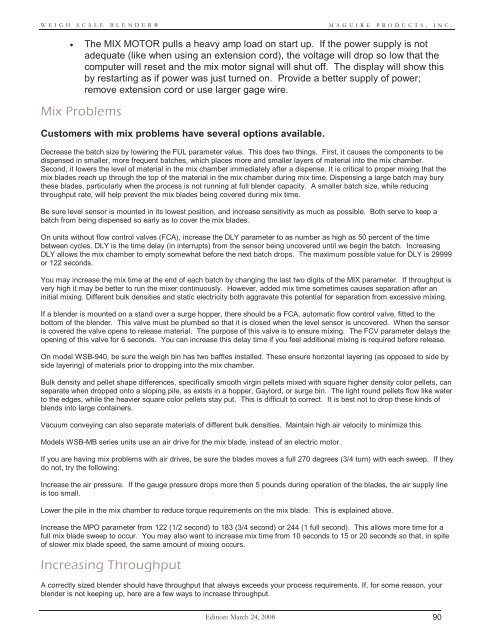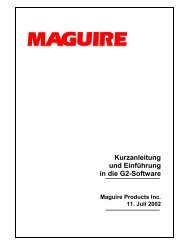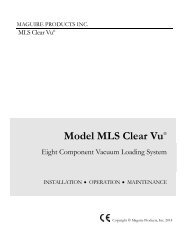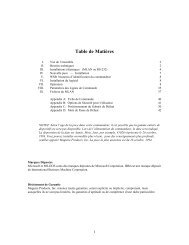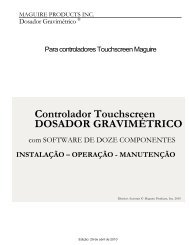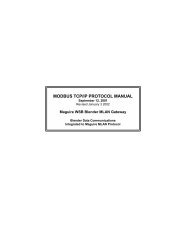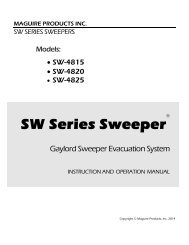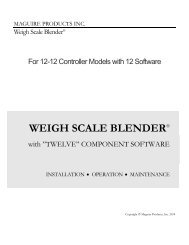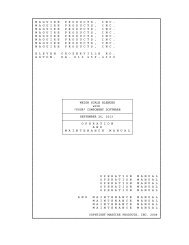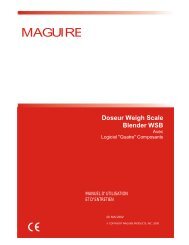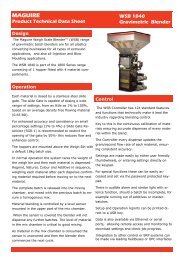WEIGH SCALE BLENDER® - Maguire Products
WEIGH SCALE BLENDER® - Maguire Products
WEIGH SCALE BLENDER® - Maguire Products
Create successful ePaper yourself
Turn your PDF publications into a flip-book with our unique Google optimized e-Paper software.
<strong>WEIGH</strong> <strong>SCALE</strong> <strong>BLENDER®</strong><br />
MAGUIRE PRODUCTS, INC.<br />
• The MIX MOTOR pulls a heavy amp load on start up. If the power supply is not<br />
adequate (like when using an extension cord), the voltage will drop so low that the<br />
computer will reset and the mix motor signal will shut off. The display will show this<br />
by restarting as if power was just turned on. Provide a better supply of power;<br />
remove extension cord or use larger gage wire.<br />
Mix Problems<br />
Customers with mix problems have several options available.<br />
Decrease the batch size by lowering the FUL parameter value. This does two things. First, it causes the components to be<br />
dispensed in smaller, more frequent batches, which places more and smaller layers of material into the mix chamber.<br />
Second, it lowers the level of material in the mix chamber immediately after a dispense. It is critical to proper mixing that the<br />
mix blades reach up through the top of the material in the mix chamber during mix time. Dispensing a large batch may bury<br />
these blades, particularly when the process is not running at full blender capacity. A smaller batch size, while reducing<br />
throughput rate, will help prevent the mix blades being covered during mix time.<br />
Be sure level sensor is mounted in its lowest position, and increase sensitivity as much as possible. Both serve to keep a<br />
batch from being dispensed so early as to cover the mix blades.<br />
On units without flow control valves (FCA), increase the DLY parameter to as number as high as 50 percent of the time<br />
between cycles. DLY is the time delay (in interrupts) from the sensor being uncovered until we begin the batch. Increasing<br />
DLY allows the mix chamber to empty somewhat before the next batch drops. The maximum possible value for DLY is 29999<br />
or 122 seconds.<br />
You may increase the mix time at the end of each batch by changing the last two digits of the MIX parameter. If throughput is<br />
very high it may be better to run the mixer continuously. However, added mix time sometimes causes separation after an<br />
initial mixing. Different bulk densities and static electricity both aggravate this potential for separation from excessive mixing.<br />
If a blender is mounted on a stand over a surge hopper, there should be a FCA, automatic flow control valve, fitted to the<br />
bottom of the blender. This valve must be plumbed so that it is closed when the level sensor is uncovered. When the sensor<br />
is covered the valve opens to release material. The purpose of this valve is to ensure mixing. The FCV parameter delays the<br />
opening of this valve for 6 seconds. You can increase this delay time if you feel additional mixing is required before release.<br />
On model WSB-940, be sure the weigh bin has two baffles installed. These ensure horizontal layering (as opposed to side by<br />
side layering) of materials prior to dropping into the mix chamber.<br />
Bulk density and pellet shape differences, specifically smooth virgin pellets mixed with square higher density color pellets, can<br />
separate when dropped onto a sloping pile, as exists in a hopper, Gaylord, or surge bin. The light round pellets flow like water<br />
to the edges, while the heavier square color pellets stay put. This is difficult to correct. It is best not to drop these kinds of<br />
blends into large containers.<br />
Vacuum conveying can also separate materials of different bulk densities. Maintain high air velocity to minimize this.<br />
Models WSB-MB series units use an air drive for the mix blade, instead of an electric motor.<br />
If you are having mix problems with air drives, be sure the blades moves a full 270 degrees (3/4 turn) with each sweep. If they<br />
do not, try the following:<br />
Increase the air pressure. If the gauge pressure drops more then 5 pounds during operation of the blades, the air supply line<br />
is too small.<br />
Lower the pile in the mix chamber to reduce torque requirements on the mix blade. This is explained above.<br />
Increase the MPO parameter from 122 (1/2 second) to 183 (3/4 second) or 244 (1 full second). This allows more time for a<br />
full mix blade sweep to occur. You may also want to increase mix time from 10 seconds to 15 or 20 seconds so that, in spite<br />
of slower mix blade speed, the same amount of mixing occurs.<br />
Increasing Throughput<br />
A correctly sized blender should have throughput that always exceeds your process requirements. If, for some reason, your<br />
blender is not keeping up, here are a few ways to increase throughput.<br />
Edition: March 24, 2008 90


